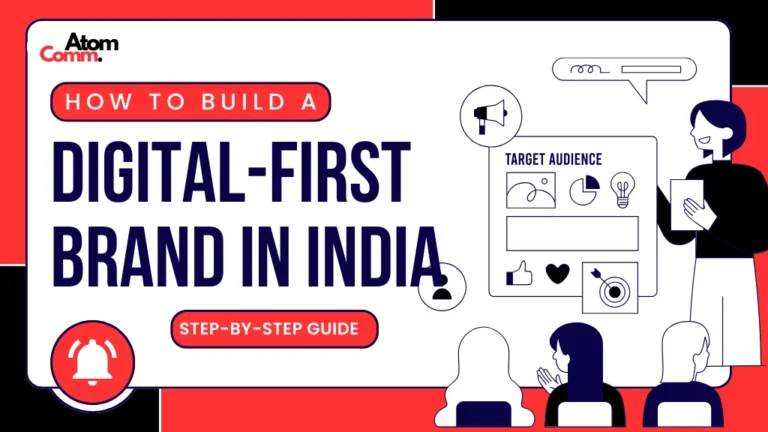How to Build a Digital-First Brand in India (Step-by-Step Guide)
In today’s competitive Indian startup ecosystem, visibility means growth. With thousands of businesses vying for attention, AtomComm’s strategic PR programs have helped brands cut through the noise—positioning them as trusted leaders, building lasting credibility, and driving measurable business impact.
Digital-First Matters in India 2026
Leverage Social Media & Paid Ads
Digital Trust Platform

For Indian businesses in 2026, being digital-first is no longer optional—it’s the foundation of sustainable growth. Today’s consumers don’t just interact with brands online; they discover, compare, and purchase almost entirely through digital channels. A brand without a strong digital presence risks losing visibility, credibility, and customer trust.
From D2C brands competing in India’s crowded e-commerce space to SaaS companies targeting global clients and fintech startups redefining trust in finance, going digital-first has become the default strategy for survival and expansion. This guide takes you through the step-by-step process of creating a digital-first brand in India, highlighting strategies, tools, and real-world outcomes.
Why Digital-First Matters in India 2026
India’s digital economy is expected to hit $1 trillion by 2030, and startups are already leading this transformation. With 1.1 billion internet users and more than 900 million smartphone connections, digital is now the first and primary touchpoint for most consumers.
Digital-first doesn’t just mean setting up a website or running ads—it’s about embedding digital thinking in every layer of your business model. From customer acquisition and service delivery to brand storytelling and retention, everything must be aligned with digital-first behavior.
Consider this:
- A D2C skincare startup can acquire 70% of its customers directly through Instagram Reels and influencer marketing.
- A SaaS company in Bangalore can generate international leads by combining LinkedIn campaigns with SEO-driven content.
- A fintech app in India can build consumer trust by offering transparent digital onboarding and AI-powered support.
👉 Already exploring growth strategies? Don’t miss our detailed blog on Social Media Packages for Indian Startups in 2026.
Step-by-Step Guide to Building a Digital-First Brand
1. Define Your Brand Identity
Every digital-first brand begins with clarity of purpose. Your mission, vision, and voice must align with your target audience. Indian consumers, especially Gen Z and millennials, value authenticity and trust.
For instance, Nykaa built its identity around accessible beauty for Indian skin tones, while Zerodha focused on transparency in stock trading fees. A clear brand identity ensures consistency across websites, apps, and social media.
2. Build a Mobile-First Website
With over 80% of India’s internet traffic coming from mobile devices, your website must be mobile-first, not desktop-adapted.
- Speed matters: A delay of 1 second can reduce conversions by 7%.
- Navigation matters: Clean menus and clear CTAs improve retention.
- Trust matters: SSL security, easy payments, and testimonials reduce drop-offs.
Startups like Zomato and Swiggy scaled faster because they prioritized mobile-friendly UX. Your website should act as your brand’s digital headquarters, optimized for discovery (SEO), conversion (CRO), and retention.
3. Create High-Value Content
Content is no longer just blogs—it’s an ecosystem of storytelling across multiple formats.
- Educational blogs help in SEO and thought leadership.
- Video content (Reels, Shorts, YouTube) dominates consumer engagement in India.
- Podcasts and webinars are growing in B2B niches like SaaS and fintech.
- Localized content in regional languages taps into India’s Tier-2 and Tier-3 markets.
Example: Cred’s viral campaigns combine humor, celebrity endorsements, and storytelling to achieve mass visibility.
4. Leverage Social Media & Paid Ads
Social media is India’s biggest branding engine. By 2026, over 700 million Indians are expected to be active on platforms like Instagram, LinkedIn, and YouTube.
- Organic reach builds communities.
- Paid ads amplify content and target specific demographics.
- Influencer collaborations add credibility.
For startups, combining organic storytelling with paid targeting ensures cost-effective scaling. D2C brands like Mamaearth mastered this by blending influencer content with high-intent performance marketing.
5. Adopt Marketing Automation
Automation helps scale personalization without extra manpower.
- Email drip campaigns nurture leads over time.
- Chatbots handle customer queries instantly.
- CRM integration tracks customer journeys for targeted campaigns.
SaaS startups in India often report 3x higher lead conversion rates after adopting marketing automation. Tools like HubSpot and Zoho CRM make automation scalable and affordable.
6. Data-Driven Decision Making
The future of branding in India is data-led. Analytics tools like Google Analytics 4, Mixpanel, and Hotjar track consumer behavior across platforms.
- D2C brands track repeat purchase rate and CAC (customer acquisition cost).
- SaaS companies measure lead-to-MQL conversion.
- Fintech startups focus on trust metrics like drop-off during KYC.
Brands that adapt based on insights scale faster, because they align strategy with actual user behavior.
Digital-First Brand Packages in India 2026
| Package Type | Pricing (Monthly) | What's Included | Best For |
|---|---|---|---|
| Starter Plan | ₹35,000 – ₹50,000 | Mobile-first website, SEO basics, 8-10 social posts, analytics setup | Early-stage startups |
| Growth Plan | ₹60,000 – ₹90,000 | Advanced SEO, 15-20 posts, paid ad campaigns, CRM integration | D2C & SaaS companies |
| Premium Plan | ₹1,00,000+ | Full-stack strategy, influencer marketing, video content, 24/7 analytics dashboard | Scaling startups & fintech |
Proof & Outcomes
D2C: Brands like Boat and Mamaearth achieved 40% faster customer acquisition through digital-first storytelling.
SaaS: Indian SaaS leaders like Zoho scaled globally with content-driven inbound marketing.
Fintech: Startups like PhonePe and Paytm increased user trust through digital-first KYC and instant support.
FAQs on Social Media Marketing in India 2026
It means prioritizing online experiences at the core of your business strategy—everything from acquisition to retention starts digital.
Depending on scale, between ₹50,000 and ₹1,00,000 monthly ensures meaningful ROI.
Instagram for D2C, LinkedIn for SaaS/B2B, and YouTube for mass awareness.
Yes. Traditional players in real estate, healthcare, and retail are now digitizing to stay relevant.
Book a Free PR Strategy Session
Tell us a bit about your brand and goals. We’ll share a tailored press plan and timeline.
